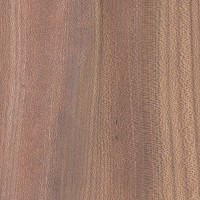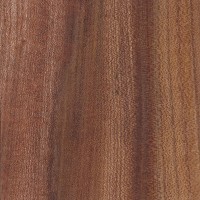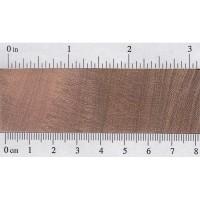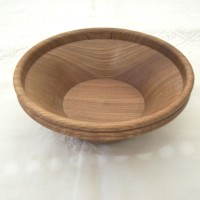 |
Common Name(s): Dutch Elm Scientific Name: Ulmus × hollandica Distribution: Europe Tree Size: 80-115 ft (25-35 m) tall, 3-5 ft (1-1.5 m) trunk diameter Average Dried Weight: 36 lbs/ft3 (575 kg/m3) Specific Gravity (Basic, 12% MC): .48, .58 Janka Hardness: 850 lbf (3,790 N) Modulus of Rupture: 9,960 lbf/in2 (68.7 MPa) Elastic Modulus: 1,091,000 lbf/in2 (7.52 GPa) Crushing Strength: 4,640 lbf/in2 (32.0 MPa) Shrinkage: No data available |
Color/Appearance: Heartwood is light to medium reddish brown. Paler sapwood is usually well defined.
Grain/Texture: Grain is interlocked (making it very resistant to splitting). With a somewhat coarse, uneven texture.
Rot Resistance: Rated as non-durable; susceptible to insect attack. Living trees are susceptible to Dutch elm disease.
Workability: Can be a challenge to work because of interlocked grain, especially on quartersawn surfaces. Planing can cause tearout and/or fuzzy surfaces. Poor dimensional stability. Glues, stains, and finishes well. Responds well to steam bending, and holds nails and screws well.
Odor: Elm usually has a strong, unpleasant smell when green; though once dried has very little odor.
Allergies/Toxicity: Although severe reactions are quite uncommon, Elm in the Ulmus genus has been reported as a sensitizer. Usually most common reactions simply include eye and skin irritation. See the articles Wood Allergies and Toxicity and Wood Dust Safety for more information.
Pricing/Availability: Should be moderately priced within its natural habitat in Europe, though availability from mature trees has been greatly diminished by Dutch elm disease.
Sustainability: This wood species is not listed in the CITES Appendices or on the IUCN Red List of Threatened Species.
Common Uses: Boxes, baskets, furniture, hockey sticks, veneer, wood pulp, and papermaking.
Comments: Elm trees are commonly infected with Dutch elm disease, a fungal disease spread by elm bark beetles. D.E.D. has wiped out millions of Elm trees worldwide.
Scans/Pictures: There are currently no pictures of this exact wood species, but a similar species within the Ulmus genus is being substituted (U. glabra). If you’d like to contribute a wood sample of this specific species to be scanned, (even small pieces of veneer can be sent), please use the contact form.








hey, i make drumsticks and this wood are so strong an durable
I am sculpting/carving on a tree trunk that is elm that was cut down because it has dutch elm. I have been sanding, grinding, and using a dremel, and am touching it constantly. I usually wear gloves, but sometimes not. When I sand/grind/dreme I use either a mask or bandana, and protective eye gear. Someone mentioned today to me that working with elm that has had DED is dangerous. I’m sure there have been times I have breathed in sawdust, I know I’ve gotten some in my eyes (and rinsed because I wear contacts). Am I in danger? Thank you… Read more »
I’m certainly no doctor, but anecdotally I can say that I’ve worked with a few pieces of elm that had succumbed to DED and I’m still alive. =)
I’d imagine it’s not too unlike working with spalted woods.
I’m certainly no doctor, but anecdotally I can say that I’ve worked with a few pieces of elm that had succumbed to DED and I’m still alive. =)
I’d imagine it’s not too unlike working with spalted woods.
I am sculpting/carving on a tree trunk that is elm that was cut down because it has dutch elm. I have been sanding, grinding, and using a dremel, and am touching it constantly. I usually wear gloves, but sometimes not. When I sand/grind/dreme I use either a mask or bandana, and protective eye gear. Someone mentioned today to me that working with elm that has had DED is dangerous. I’m sure there have been times I have breathed in sawdust, I know I’ve gotten some in my eyes (and rinsed because I wear contacts). Am I in danger? Thank you… Read more »